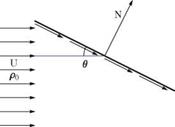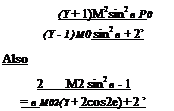Newtonian Flows
The impact theory Newton proposed, is simply to calculate the normal force on a plate at angle в in terms of the change of normal momentum, i. e. (Fig. 12.3)
N = Ap0U2 sin2 в (12.121)
hence
Cp = P – P0 = 2sin2 в (12.122)
2 P0U 2
For a curved surface, the modified Newtonian theory is
Cp = Cp, max sin2 в (12.123)
where Cp, max is the stagnation pressure coefficient. Indeed, as M0 ^ ж, the flow across a normal shock gives Cp, max = 2. However, for finite M0, Cp, max < 2. See Fig. 12.4.
On the other hand, the oblique shock relations are given by

 Fig. 12.3 Newton’s impact theory
Fig. 12.3 Newton’s impact theory
Fig. 12.4 Modified Newton’s theory
 |
|
since both в and в are small.
 |
The pressure coefficient is given by
where U and R are the mean values of the velocity and of radius of curvature of the thin layer of thickness N, see Fig. 12.5.
The mass flow rate past a section of a body of revolution is given by
Ґ 2
m = 2nr pudn — nr zp0U (12.128)
0
Notice, rs — r. Hence
Fig. 12.5 Shock layer
и r r, r и
Ap = P0U2, and Cp = (12.129)
R 2 R U
As M0 and y ^ 1, a particle entering the shock with a tangential velocity
U cos в retains that velocity, therefore the mean velocity U is
1 Ґ
u= 2nrU cos edr (12.130)
nr2 0
The radius of curvature of the thin layer is governed by
r d в
= r sin в (12.131)
R dr
Hence,
sin в dв r
ACP = 2 cos вrdr (12.132)
r dr 0
Let A = nr2, the cross-sectional area; The modified surface pressure coefficient given by Busemann is
2 dв fA
Cp = 2 sin2 в + 2 sin в cos вdA (12.133)
dA J0
For a sphere, the above relation becomes
Cp = 2^1 – 4 sin2 ^ (12.134)
Lighthill [65] suggested that the shock wave separates from the surface of the sphere at the point of vanishing Cp, в = 60° measured from the forward stagnation point, Fig. 12.6.
 Fig. 12.6 Sphere in Hypersonic Flow
Fig. 12.6 Sphere in Hypersonic Flow
The shape of the shock wave may be determined from
d – a
0 = 2sin2 в + 2sine – cos edA (12.135)
dA Jq
It can be shown that the shock shape tends asymtotically to be y ~ x1/3.
The modified Newton-Busemann formulas for slender bodies are
Cp = Cp0 (в2 + Г-‘J, for axisymmetric flow (12.136)
Cp = Cp0 (в2 + y-‘J, for plane flow (12.137)
For cones and wedges, the Busemann corrections vanish and the Newtonian formulas are consistent with the shock relations as M0 ^<x> and у ^ 1.











